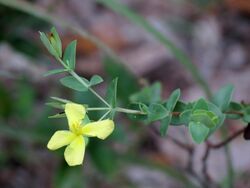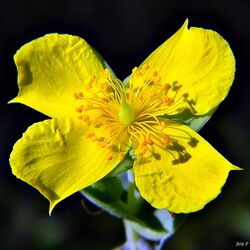Biology:Hypericum tetrapetalum
| Hypericum tetrapetalum | |
|---|---|

| |
| Scientific classification | |
| Kingdom: | Plantae |
| Clade: | Tracheophytes |
| Clade: | Angiosperms |
| Clade: | Eudicots |
| Clade: | Rosids |
| Order: | Malpighiales |
| Family: | Hypericaceae |
| Genus: | Hypericum |
| Section: | H. sect. Myriandra |
| Subsection: | H. subsect. Ascyrum |
| Species: | H. tetrapetalum
|
| Binomial name | |
| Hypericum tetrapetalum Lam.[1]
| |
| Synonyms[2] | |
| |
Hypericum tetrapetalum, the fourpetal St. Johnswort,[3] is a species of flowering plant in the St. John's wort family, Hypericaceae.[4] It is found in the Southeastern United States and Cuba.[4] It was first described by Jean-Baptiste Lamarck in 1797.[1][2]
Description
Fourpetal St. Johnswort is a perennial herb or small shrub with a woody base, growing 20–100 cm (7.9–39.4 in) tall. Young stems are two- or four-lined, becoming two-lined or terete as they age. The leaves are oblong to triangular-ovate, 5–35 mm (0.20–1.38 in) long, 4–15 mm (0.16–0.59 in) across, with heart-shaped, clasping bases. The terminal flowerheads produce one to three flowers, each flower 20–30 mm (0.79–1.18 in) in diameter with 4 bright yellow petals and about 100 stamens. It produces flowers throughout most of the year.[5][6] The capsules are three-parted.[5]
It is distinguished from the closely related Hypericum crux-andreae by its broader leaves with clasping bases.[5] Their distribution overlaps in southern Georgia and northern Florida, but apparent hybrids have not been observed.[4]
Distribution and habitat
In the United States, H. tetrapetalum is found in Alabama, Georgia, and Florida. It is also found in western Cuba.
H. tetrapetalum occurs in wet pinelands and ditches in sandy soil.[5][4]
References
- ↑ 1.0 1.1 "Hypericum tetrapetalum Lam.". International Plant Names Index. https://beta.ipni.org/n/433904-1.
- ↑ 2.0 2.1 "Hypericum tetrapetalum Lam.". Royal Botanical Gardens Kew. https://powo.science.kew.org/taxon/urn:lsid:ipni.org:names:433904-1.
- ↑ "Hypericum tetrapetalum". Natural Resources Conservation Service PLANTS Database. USDA. https://plants.usda.gov/core/profile?symbol=Hyte4. Retrieved 2018-11-04.
- ↑ 4.0 4.1 4.2 4.3 "Hypericum tetrapetalum Lam. Descriptions". http://hypericum.myspecies.info/taxonomy/term/925/descriptions.
- ↑ 5.0 5.1 5.2 5.3 Robson, Norman K. B. (2015), "Hypericum tetrapetalum", in Flora of North America Editorial Committee, Flora of North America North of Mexico (FNA), 6, New York and Oxford, http://www.efloras.org/florataxon.aspx?flora_id=1&taxon_id=250100865, retrieved 2018-11-04
- ↑ "Hypericum tetrapetalum (Fourpetal St. Johnswort): Plant Phenology". https://www.inaturalist.org/taxa/128076-Hypericum-tetrapetalum.
Wikidata ☰ Q17812788 entry
 |


